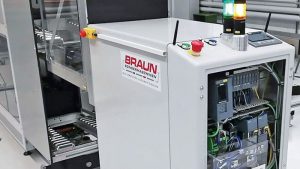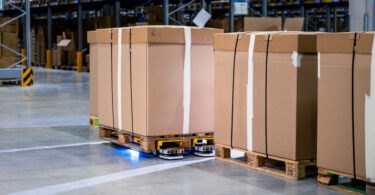Autonomous mobile robots are ideal for use in the logistics industry where products are loaded and shipments are prepared
Loading and unloading is the core business of mobile robots and the company Braun Sondermaschinen GmbH has developed a mobile robot that can do this autonomously.
The autonomous mobile robot (AMR) is called the BS Trayshuttle and can pick up stacks of small load carriers or trays from one pallet handling machine and put them down in another pallet handling machine. More specifically, the task of the BS Trayshuttle is to determine positions, take distance measurements, and navigate reliably. Comprehensive sensor solutions from SICK have been employed to enable them to master all of these different challenges.
The mobile robot can pick up loads completely independently from one pallet handling machine and put them down in another. The BS Trayshuttles safeguard and increase the productivity and efficiency of the entire assembly line by making the internal transport logistics as effective as possible. When determining which sensors would be used, Braun Sondermaschinen turned to SICK. The result was an AMR with software that can be programmed to precisely suit the processes on-site.
The BS Trayshuttle in action
The BS Trayshuttle is precisely programmed for its application on-site and knows its way around. To set it in motion, all that is required is the press of a green start button on the vehicle and it automatically starts to move. It leaves its station and travels to the specified target location to start loading and unloading goods.
The transport system moves itself into position at a defined area in front of the rack and sensors assist with correctly determining the location. Next, the BS Trayshuttle extends its tray, which is a surface integrated into the vehicle onto which goods can be placed. The sensors begin to determine how far the tray needs to be extended to optimally transfer the goods and is also controlled by sensors.
The unit itself is height-adjustable so the transfer can occur at different points. Once the exchange is complete, the tray retracts again. To increase efficiency further, it’s possible to visit multiple bays in sequence. For example, the BS Trayshuttle first transfers a product to one bay, then moves up to the next bay to pick up a new product, which it then transports to the next location. This is no problem at all thanks to the variable tray transfer height of 200 mm up to 1,200 mm. When the AMR is no longer required, it returns to its charging station and waits for the next job.
To implement the BS Trayshuttle, an AMR, which has successfully been used in other applications, from the company MiR was selected. The technical setup of the BS Trayshuttle is mounted on an MiR250 and the AMR is equipped with a Flexi Soft safety controller and a nanoScan3 safety laser scanner.
Due to the small and compact construction of the nanoScan3, it was possible to achieve a space-saving design for the MiR250. The two nanoScan3 devices provide complete protection to the vehicle and the Flexi Soft, which is installed as standard, ensures safe operation. There can be up to 128 freely configurable protective fields of the laser scanner and, when one is breached by a person, safe operation is still ensured. Besides safe operation, this combination also offers a maximum level of flexibility for adapting the speed and direction of travel of the vehicle.
All sensors in the AMR come from SICK. A PowerProx WTT12L MultiTask photoelectric sensor is used for determining the position of the trays, and a W4-3 miniature photoelectric sensor for querying their end position. The position of trays on the vehicle itself is determined by an IME2S inductive proximity sensor.
Other challenges associated with the BS Trayshuttle have also been solved using the sensor technologies from SICK. For example, a WTT12L measures distances within the vehicle to correctly load and unload the tray and inductive sensors check whether the correct location has been reached.
To enable the AMR to glide about the factory at up to 7 km/h with ease, particular attention needs to be placed on the safety technology. Understanding how the vehicle should respond in specific situations, and what solutions are required to achieve a smooth process are both important factors.
Braun Sondermaschinen collaborated intensively with SICK and this made finding solutions to a wide variety of challenges on site possible. In the end, a mobile robot was created that is tailored to the specific requirements of Braun Sondermaschinen’s customers. The existing collaborative relationship between Braun Sondermaschinen and SICK was also strengthened because of this project.
Want to learn more about this solution?







